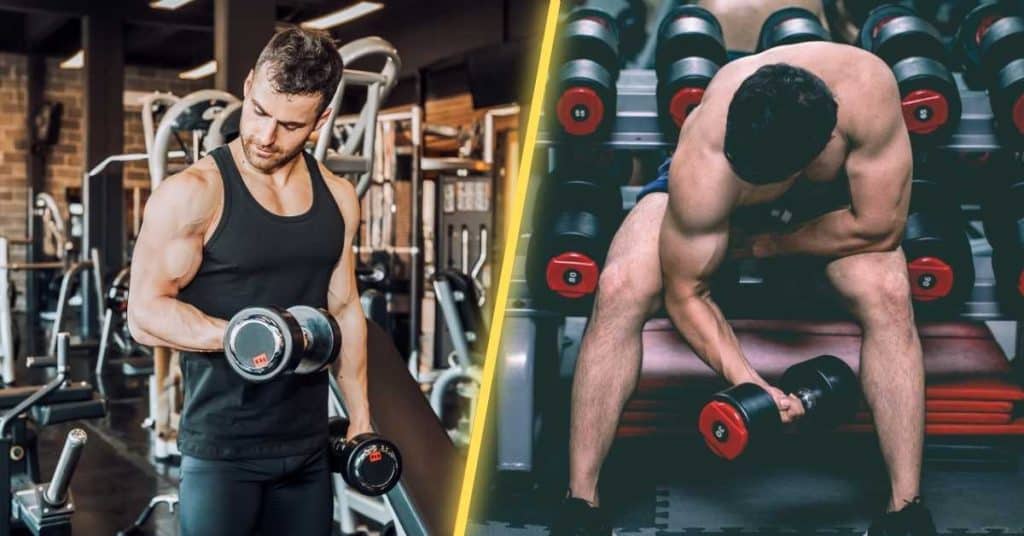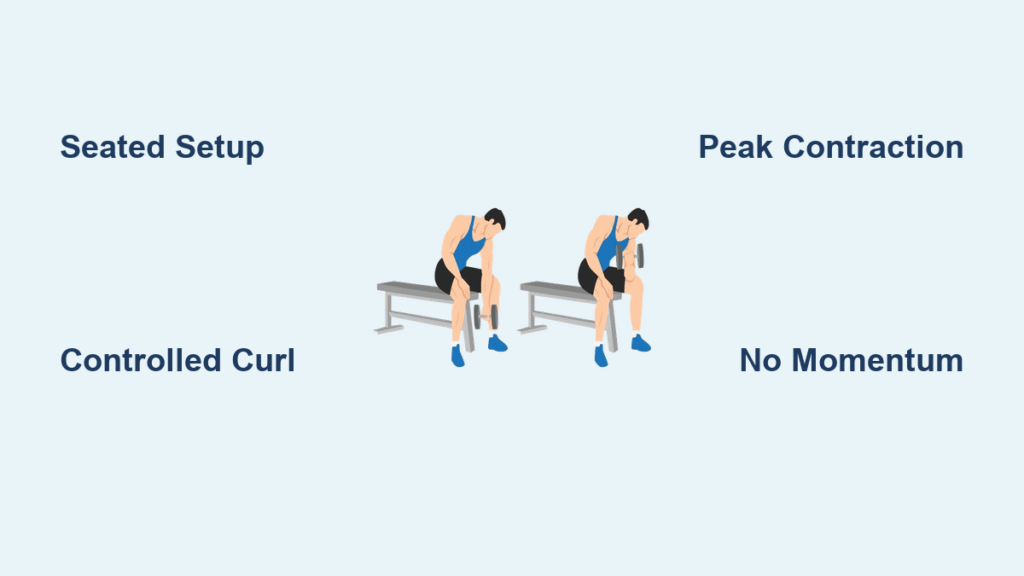You’ve been lifting weights for months, yet one bicep still lags behind its twin in the mirror. This frustrating imbalance plagues most lifters who rely solely on barbell curls where the dominant arm compensates. The solution? Dumbbell concentration curls—the ultimate unilateral bicep builder that forces each arm to work independently. Unlike other curl variations, this isolation movement eliminates cheating and delivers intense peak contraction exactly where you need it. In this guide, you’ll discover the precise setup, muscle activation secrets, and subtle technique tweaks that transform average arms into symmetrical masterpieces.
Stop wasting gym time with half-reps and momentum swings. Proper dumbbell concentration curls uniquely target the biceps brachii while exposing strength discrepancies between arms. With over 3 million sets logged globally, this intermediate-level exercise ranks as a top isolation movement for building that coveted bicep peak. Whether you’re battling stubborn imbalances or chasing razor-sharp definition, mastering this movement delivers results no other curl can match.
Why Dumbbell Concentration Curls Crush Muscle Imbalances
Biceps Brachii: The Peak Builder
Your biceps brachii receives unparalleled isolation during dumbbell concentration curls, with both the short head (from the front of your shoulder blade) and long head (from the back) firing intensely. As you curl, these fibers converge at your forearm to create powerful elbow flexion while maintaining supination—your palm facing upward throughout the movement. This constant tension triggers hypertrophy precisely in the bicep peak region where most lifters seek definition.
Core and Stabilizer Engagement
Don’t be fooled by the isolation label—your entire kinetic chain activates during dumbbell concentration curls. Your forearms lock the supinated grip position while your trapezius, obliques, and erector spinae create a rock-solid platform. The levator scapulae subtly stabilizes your shoulder blade, preventing rotation that would steal tension from your biceps. This full-body engagement is why even lighter weights feel brutally effective.
Perfect Seated Setup for Maximum Tension

Bench Position and Body Alignment
Sit on the end of any flat bench with your feet planted wider than shoulder-width. Hinge forward at your hips until the meatiest part of your triceps—not your elbow—presses firmly against your inner thigh. This critical adjustment creates an immovable anchor point while preventing joint strain. Your working arm should hang straight down with the dumbbell resting lightly on the floor when fully extended.
Hand and Arm Placement Secrets
Drive your triceps hard into your thigh to eliminate any movement during the curl. Place your non-working hand on the opposite knee for stability, fingers spread wide to engage your core. Crucial detail: Keep your spine neutral and chest up throughout—never round your back. Your upper arm must stay perfectly perpendicular to the ground from start to finish, like a piston in a cylinder.
Execution Technique Breakdown
Controlled Contraction Phase
Lift the dumbbell with deliberate slowness for 2 seconds, focusing entirely on squeezing your bicep rather than moving weight. Stop the moment your triceps begins losing contact with your thigh—this indicates you’ve reached the effective range (usually when your forearm hits 45 degrees). Hold the peak contraction for 1-2 seconds while imagining crushing a walnut between your bicep and shoulder.
Eccentric Emphasis for Growth
Lower the weight with extreme control over 3-4 seconds, fighting gravity all the way down. Never lock out your elbow at the bottom; maintain a slight bend to keep constant tension on the biceps. This controlled descent triggers micro-tears that spark muscle growth—skipping this phase wastes 40% of your workout potential.
Repetition Guidelines
Complete 8-12 pristine reps before switching arms. If you can’t maintain form, reduce the weight immediately—quality always trumps quantity. Track each arm separately in your logbook; your weaker side should dictate your working weight. When both arms fatigue simultaneously at the same weight, you’ve conquered imbalances.
Standing Variation for Advanced Lifters

Unsupported Challenge
For greater functional strength, try the standing dumbbell concentration curl. Hinge forward at the waist with feet shoulder-width apart, letting your working arm hang freely between your legs. Your non-working hand grips the opposite thigh above the knee. Without thigh support, your core works 30% harder to prevent body swing—exposing any momentum habits instantly.
Form Adjustments for Stability
Start with 20-30% less weight than your seated version. Keep your upper arm stationary like a pendulum, moving only at the elbow joint. Pro tip: Extend your non-working arm straight out to your side to engage your obliques for better stability. This version builds real-world strength but demands impeccable control.
Common Form Mistakes and Fixes

Triceps vs. Elbow Placement Error
Mistake: Jamming your elbow into your thigh instead of the triceps muscle
Fix: Slide your arm down until the fleshy part above your elbow presses firmly against your leg. This creates a stable fulcrum while protecting your joint.
Range of Motion Errors
Mistake: Over-curling past effective range (dumbbell to shoulder)
Fix: Stop when your forearm reaches 45 degrees—any further disengages the biceps and strains your shoulder.
Momentum Cheating
Mistake: Leaning back or swinging your torso
Fix: Place a hand on your chest to monitor movement—zero motion should occur during the curl.
Programming for Peak Results
Standard Protocol
Perform dumbbell concentration curls 1-2 times weekly after compound movements like pull-ups or rows. Use 3-4 sets of 8-12 reps per arm with 60-90 seconds rest. Start light for 2 weeks to master form before increasing weight. Log each arm’s working weight separately—your weaker side might handle 5 pounds less initially.
Advanced Techniques
- Strength Focus: 4 sets of 6-8 reps with 2.5-5lb increases weekly
- Hypertrophy Focus: 3 sets to failure with 3-second eccentric phase
- Pre-Fatigue Method: Do 1 set of concentration curls before heavy barbell rows
Strategic Workout Placement
Always schedule dumbbell concentration curls after heavy compound lifts when your biceps are already warmed up. Pair them with incline dumbbell curls for complete long-head development or hammer curls for brachialis engagement. Never start your arm workout with this exercise—you need fresh stabilizers for perfect form.
Safety and Injury Prevention
Critical Warm-Up Protocol
Begin with 5 minutes of light cardio followed by arm circles and band pull-aparts. Do your first set with 50% working weight for 15 reps to lubricate the elbow joint. Red flag: Sharp elbow pain means stop immediately—mild muscle burn is normal; joint pain indicates form failure.
Wrist Protection Technique
Keep your wrist perfectly neutral throughout—no bending backward or forward. Imagine holding a tray of drinks; this prevents forearm tendon strain. If you experience wrist discomfort, try a Fat Gripz attachment to reduce wrist extension.
Recovery Essentials
Allow 72 hours between biceps sessions for full recovery. Post-workout, stretch by placing palms on a wall and rotating your body away for 30 seconds per arm. Monitor DOMS—severe soreness means you increased weight too fast.
Final Performance Tips
Master the mind-muscle connection by watching your bicep in the mirror during initial sets. Focus on feeling the stretch at the bottom position and the intense contraction at the peak—not just moving the dumbbell. Pro tip: Squeeze a tennis ball in your non-working hand to engage your core and stabilize your torso.
Progress patiently with dumbbell concentration curls—they punish ego lifting more than any other bicep exercise. Build your foundation with perfect form at lighter weights, then increase resistance only when you can complete all reps with strict control. Within 8 weeks of consistent practice, you’ll notice symmetrical peaks in the mirror and feel the difference when carrying groceries. This isn’t just another curl—it’s the precision tool for bicep perfection that transforms imbalanced arms into balanced masterpieces.




